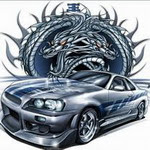

On the occasion of the 30th Birthday of the super sports car BMW M1 shows BMW Group design in the context of the Concorso d'Eleganza Villa d'Este 2008, a tribute to this legendary super sports cars. The BMW M1 by Giorgio Giugiaro was a car of quality, a highly emotional vehicle, uncompromising in racing trimmed. This development has launched the BMW turbo by Paul Bracq, a revolutionary concept car, in addition to his groundbreaking, functional design and a variety of technology innovations barg. In line with these two unique vehicles was the BMW M1 Homage. A design study in honour of previous models - a sign of competence, creativity and potential of the BMW Group design team.
"For BMW tradition means always lived tradition. Inspiration from our own history and to be re-invent - just showing the BMW M1 Homage Car impressive manner." Dr. Klaus Draeger, Member of the Executive Board of BMW Group, development
A particular strength of BMW Group Design is strong in its own history to good use and actively engaged in shaping the future due to leave. The BMW M1 Homage is a design study in the tradition of a BMW turbo, is the contemporary view of a BMW M1 and the mid-engine concept. This demonstrates an emotional tribute design, technology shows and in the overall aesthetics of the vehicle.
The Concorso d'Eleganza Villa d'Este offers the perfect environment for the BMW M1 Homage. Here automobile beauties of yesterday at the concept cars and design studies of tomorrow. In this tension between tradition and modernity granted the BMW Group design team insight into their own vision of a historically inspired automotive future.
Emotional Design in tension between tradition and modernity.
The BMW M1 Homage already known uses elements from the BMW design repertoire, interprets it and puts it into a new context. Its design tradition and modernity meet, he extended viewing habits with new design solutions, the BMW typical form expression. Was the BMW M1 the color contrast design main theme, with the BMW M1 Homage of the contrast in the design continued. Already familiar elements, such as the typical proportions, with exciting new lines, surfaces and details about a contemporary interpretation of the still outstanding BMW M1 combined.
Contrary to the strong wedge shape other mid-engine vehicles, the BMW M1 Homage is true to the BMW typical proportions. A relatively long bonnet, a clearly defined transition into the A-pillar and a stretched window graphic with Hofmeisterknick let in immediately as a real BMW. The horizontal lines reduces the optical focus of the vehicle and emits sovereignty. Body the BMW M1 has very smooth and athletic proportions, the surface design is still no explicit design theme - contrasting themes dominated graphics. Currently, however, in addition to the proportions especially the extraordinary The design of the high recognition value of a BMW vehicle. For some years all BMW models show a significant and unique form of language. The modeling of the land requires a lot of experience and craftsmanship at the highest level. Only through the combination of craftsmanship, state-of-the-art technology and a secure sense of the personality of each BMW model designers and achieve your sculptural the overall impact, a BMW unique. Consequently, the BMW M1 combines tribute to the proportions and graphic themes of the BMW M1 with a surface language of the new BMW design line. This combination gives the vehicle an exciting, sporting and authentic emotion.
The front design of the BMW M1 Homage takes many graphic design themes of the BMW M1: The color contrast between black areas and reset the car color, flat and small kidney and the "invisible" headlights. However, the front of the BMW M1 Homage an absolute first for BMW. Each element has a function. For example, the typical double kidney not only recognizable characteristic of the BMW brand, but combines solutions to the issues aerodynamics, cooling and security. The design of the headlights turn interprets the fold-out front lamps of the BMW M1. As the lights of the historical model, the BMW M1 Homage only visible in the on mode. In integrate themselves off the headlights discreetly in the front design and are "invisible" in the reset, black fugue - almost like the retracted headlights.
In the side of the vehicle, all the lines, surfaces and details the eye from the front on the long bonnet and clearly defined the A-pillars along and condense the center of the vehicle. Two expressive lines drawn from the front on the side of the vehicle, to the area of the engine compartment. The line begins disciplined and straight in the front, lower than optical focus of the BMW M1 Homage and stresses its low road. From the middle of the vehicle to break the lines, however. The power of design focuses on exactly the area where the power of the vehicle - in the engine. Strong and sensual turns accentuate the mid-engine concept of the vehicle. The design emphasizes the mechanics behind the engineering and motor competence of the BMW Group.
The roof line of the BMW M1 Homage runs flat, moves into the back inside and around the stern around. It draws a solid line and connects the two sides together vehicle. On this line will be held in the rear of the rear lights, the typical BMW emblem double its place.
"Engineering is beautiful - let's show it!"
The entire design is very functional, every detail has a purpose. Topics such as aerodynamics, cooling air safety management and give the BMW M1 Homage technical matter and only make him a real BMW. The kidneys design of the BMW M1 Homage met several functions: It is not only typical BMW identifier, but also part of the sophisticated aerodynamics, it serves the airflow for engine cooling and is also the front of a crash-Box -- similar to the monocoque chassis of a Formula 1 racing car.
Inspired by the aircraft, the entire vehicle also has a sophisticated air flow through the body. Thus, for example, below the roof line, in the black reset the gap behind the vehicle side window graphics, the cold air flow for the engine space. Small openings fins and deflect the airflow into the engine room and provide sufficient airflow.
Vision and inspiration.
"The BMW M1 Homage clearly shows the creativity and potential of the BMW design team. A project like this is a valuable source of inspiration for our daily work." Adrian van Hooydonk, head of BMW Automobile Design
The BMW M1 Homage is of great importance for the BMW Group design team, is his creation process but is symbolic of living tradition and innovative future. The vehicle is intended as a source of inspiration and motivation to do this, Withdraw into question and to rethink. The BMW M1 Homage honors the BMW Turbo and the BMW M1, with their design of their time far ahead. Originally only as a design study or small series planned, their influence even today - 30 years later - still clearly visible.

































